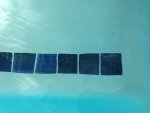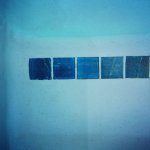First post! Hello everyone :-D
Until this week I had an easy pool, very stable and crystal clear with gleaming white plaster walls. I was testing every other day and kept everything fairly consistently within the recommended ranges.
On Monday I noticed the Cl was low – almost zero. In the aftermath of some heavy use and rain I wasn’t surprised: it was due a pool shock. Whilst shocking I noticed the beginnings – fewer than ten 1" circles – of green/yellow algae on the walls. I scrubbed them away – and brushed my entire pool – as well as pool-shocking and brushing for the next 3 days straight. The yellow/green algae patches disappeared. The water was crystal clear (it never wasn't). The Cl (TC & FC) held its ppm nicely.
But yesterday (Thursday) and today even more so I noticed:
- grey/blue/brown speckles on areas that are prone to poor circulation and gathering organic matter (e.g. steps and benches)
- larger areas of the walls and floor that look less than bright white (greyish), especially in low light
These markings only emerged in the aftermath of the super-chlorination. None of them brushes off.
Factors to consider:
- I found out today the phosphate level is very high (2500ppb). This come as a shock, since we do our own gardening, the pool was only filled in April and we haven’t been near it with fertilisers or mulch. The only organic matter to have entered the pool is palm flowers (‘tis the season!).
- Historically, I had been keeping my Cl at the low end of the recommended range on the recommendation of the pool builder because I have an ozone-generator…
- The temperature these past couple of weeks has shot up to the 90s/100s (I’m in Houston).
- The chemistry (apart from phosphates) is otherwise fine. Cl slightly too high now on purpose. CH slightly low but will get to that after phosphates. pH within range to let the chemicals do their job….
First things first, I must rid my pool of the phosphates (beginning now). In a day or two, I need to tackle the speckling and greying issues.
But the question is, am I dealing with (duh duh duuuuuh!) black algae or is it some consequence of super-chlorinating so intensively (a metal or calcium deposit)? Or something else altogether (plaster)?
Photo below of the speckles. Tiles are 3”x3”, to give you a sense of scale.
THANK YOU in advance
Until this week I had an easy pool, very stable and crystal clear with gleaming white plaster walls. I was testing every other day and kept everything fairly consistently within the recommended ranges.
On Monday I noticed the Cl was low – almost zero. In the aftermath of some heavy use and rain I wasn’t surprised: it was due a pool shock. Whilst shocking I noticed the beginnings – fewer than ten 1" circles – of green/yellow algae on the walls. I scrubbed them away – and brushed my entire pool – as well as pool-shocking and brushing for the next 3 days straight. The yellow/green algae patches disappeared. The water was crystal clear (it never wasn't). The Cl (TC & FC) held its ppm nicely.
But yesterday (Thursday) and today even more so I noticed:
- grey/blue/brown speckles on areas that are prone to poor circulation and gathering organic matter (e.g. steps and benches)
- larger areas of the walls and floor that look less than bright white (greyish), especially in low light
These markings only emerged in the aftermath of the super-chlorination. None of them brushes off.
Factors to consider:
- I found out today the phosphate level is very high (2500ppb). This come as a shock, since we do our own gardening, the pool was only filled in April and we haven’t been near it with fertilisers or mulch. The only organic matter to have entered the pool is palm flowers (‘tis the season!).
- Historically, I had been keeping my Cl at the low end of the recommended range on the recommendation of the pool builder because I have an ozone-generator…
- The temperature these past couple of weeks has shot up to the 90s/100s (I’m in Houston).
- The chemistry (apart from phosphates) is otherwise fine. Cl slightly too high now on purpose. CH slightly low but will get to that after phosphates. pH within range to let the chemicals do their job….
First things first, I must rid my pool of the phosphates (beginning now). In a day or two, I need to tackle the speckling and greying issues.
But the question is, am I dealing with (duh duh duuuuuh!) black algae or is it some consequence of super-chlorinating so intensively (a metal or calcium deposit)? Or something else altogether (plaster)?
Photo below of the speckles. Tiles are 3”x3”, to give you a sense of scale.
THANK YOU in advance





